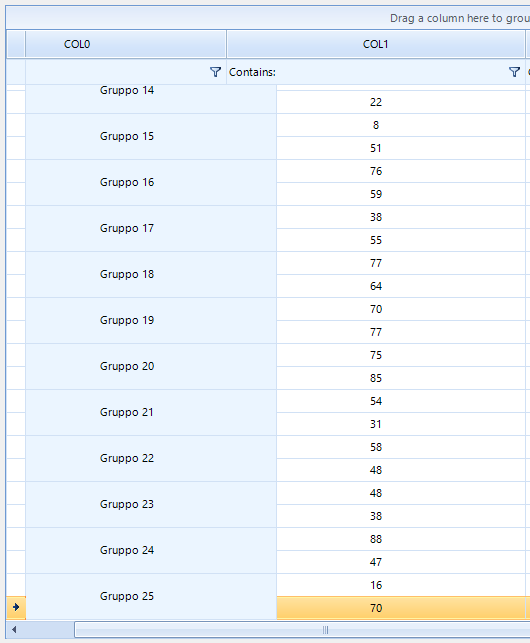Completed
Last Updated:
12 Dec 2025 10:29
by ADMIN
Release 2025.4.1212 (Preview)
Created by:
Julian
Comments:
1
Category:
GridView
Type:
Bug Report
In this scenario, we are using the custom approach from the How to Change PageViewMode for the Nested Levels in RadGridView KB article. When a child row is expanded and we collapse and expand its parent, an exception is thrown.
Completed
Last Updated:
17 Sep 2025 14:26
by ADMIN
Release 2025.3.917 (Preview)
Created by:
Riziq
Comments:
5
Category:
GridView
Type:
Bug Report
When a CommandColumn cell is focused and we try to focus an external control, the RadGridView can't lose focus. The internal code will force the control to focus the CommandColumn cell again.
Completed
Last Updated:
12 Nov 2025 11:45
by ADMIN
Release 2025.4.1111 (2025 Q4)
Created by:
Jackson
Comments:
1
Category:
GridView
Type:
Bug Report
Excel-like pop-up location is not scaled properly on High DPI.
Completed
Last Updated:
25 Aug 2025 07:59
by ADMIN
Release 2025.3.812 (2025 Q3)
Created by:
Pierre
Comments:
1
Category:
GridView
Type:
Bug Report
Clicking the filter icon will reopen the filter popup. In the following scenario, the filter pop-up is open. If we click the filter icon while the filter popup is open, it will close it and reopen it. This leaves the end user with flashing behavior. The filter icon should close the filter popup if it is open.
Completed
Last Updated:
21 May 2025 10:52
by ADMIN
Release 2025.2.520 (2025 Q2)
Created by:
Larry
Comments:
1
Category:
GridView
Type:
Bug Report
In the following scenario, we have enabled the pager functionality of the control. If we move to a different page and then set the DataSource to Null, the page index will not be reset.
Completed
Last Updated:
21 May 2025 10:52
by ADMIN
Release 2025.2.520 (2025 Q2)
Created by:
Julian
Comments:
2
Category:
GridView
Type:
Bug Report
The EnableHotTracking property works only in the first level hierarchy. The lower levels still get highlighted.
Completed
Last Updated:
12 Jun 2025 07:57
by ADMIN
Release 2025.2.612 (Preview)
Created by:
Graeme
Comments:
1
Category:
GridView
Type:
Bug Report
Steps to recreate:
- click on the button on the top row
- press the down key on the keyboard
- Press Space key to select new button, the button on the top row is clicked
Completed
Last Updated:
10 Mar 2025 14:41
by ADMIN
Release 2025.1.310 (Preview)
Created by:
Holger
Comments:
1
Category:
GridView
Type:
Bug Report
This behavior is observed when referencing 2025.1.211 version of Telerik UI for WinForms controls.
Completed
Last Updated:
21 May 2025 10:52
by ADMIN
Release 2025.2.520 (2025 Q2)
Created by:
Dietmar Hasse
Comments:
1
Category:
GridView
Type:
Bug Report
In this scenario, the MultiSelect option of the control is enabled. If we click and hold the mouse to select multiple cells and go over a merged cell, NullReferenceException is thrown.
Completed
Last Updated:
21 May 2025 10:54
by ADMIN
Release 2025.2.520 (2025 Q2)
Created by:
Larry
Comments:
1
Category:
GridView
Type:
Bug Report
In this scenario, we have custom RadListFilterPopup. There could be a scenario in which we don't need the default menu items( input textbox, list of distinct values, buttons). If we override the CreateListFilterMenuItems() method and don't call the base code, NullReferenceException will be thrown in the Dispose() method.
Completed
Last Updated:
21 May 2025 10:53
by ADMIN
Release 2025.2.520 (2025 Q2)
Created by:
Holger
Comments:
1
Category:
GridView
Type:
Bug Report
In the current scenario, when clicking on the checkbox inside a GridViewCheckBoxColumn, the CellBeginEdit event will be called. If we cancel the event by setting the Cancel property to true, the CellBeginEdit will be called twice.
Completed
Last Updated:
12 Feb 2025 12:41
by ADMIN
Release 2025.1.211 (2025 Q1)
Created by:
Dietmar Hasse
Comments:
1
Category:
GridView
Type:
Bug Report
The CellSpacing property value is not taken into account. This property has different value in different themes.
Completed
Last Updated:
12 Feb 2025 12:41
by ADMIN
Release 2025.1.211 (2025 Q1)
Created by:
Andrea
Comments:
1
Category:
GridView
Type:
Bug Report
System.ArgumentException: 'An item with the same key has already been added.' when the data source contains DateTime with the same hour, minute, and seconds part (only milliseconds are different):
Completed
Last Updated:
12 Feb 2025 12:40
by ADMIN
Release 2025.1.211 (2025 Q1)
Created by:
erwin
Comments:
2
Category:
GridView
Type:
Bug Report
Calling the BestFitColumns() method after setting the DataSource will not resize the columns. The method logic is called before the internal measure of the control is finished.
Completed
Last Updated:
12 Feb 2025 12:41
by ADMIN
Release 2025.1.211 (2025 Q1)
Created by:
fabrizio
Comments:
1
Category:
GridView
Type:
Bug Report

Completed
Last Updated:
27 Nov 2024 14:43
by ADMIN
Release 2024.4.1127 (Preview)
Created by:
fabrizio
Comments:
1
Category:
GridView
Type:
Bug Report
Completed
Last Updated:
25 Aug 2025 07:59
by ADMIN
Release 2025.3.812 (2025 Q3)
Created by:
Nadya
Comments:
0
Category:
GridView
Type:
Feature Request
Add support for UI Automation in RadGridView control.
Completed
Last Updated:
27 Nov 2024 14:43
by ADMIN
Release 2024.4.1127 (Preview)
Created by:
fabrizio
Comments:
1
Category:
GridView
Type:
Bug Report
The following line gets serialized when set this property:
((Telerik.WinControls.UI.GridSelectCheckBoxElement)(this.radGridView1.GetChildAt(0).GetChildAt(0).GetChildAt(2).GetChildAt(0).GetChildAt(0).GetChildAt(1).GetChildAt(0).GetChildAt(1).GetChildAt(0))).Visibility = Telerik.WinControls.ElementVisibility.Collapsed;
Completed
Last Updated:
21 May 2025 10:52
by ADMIN
Release 2025.2.520 (2025 Q2)
Created by:
Jackson
Comments:
1
Category:
GridView
Type:
Bug Report
In this case, we have a GridViewHyperlinkColumn in which we have a cell with an empty string or null value. Exporting the control in XLSX format leads to an exception.
Completed
Last Updated:
13 Nov 2024 12:46
by ADMIN
Release 2024.4.1113 (2024 Q4)
Created by:
Julian
Comments:
1
Category:
GridView
Type:
Bug Report
This only happens initially when you first start checking/unchecking rows. See the attached gif file.



